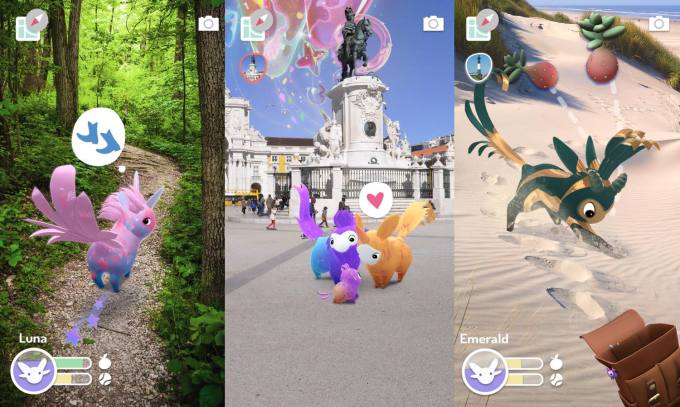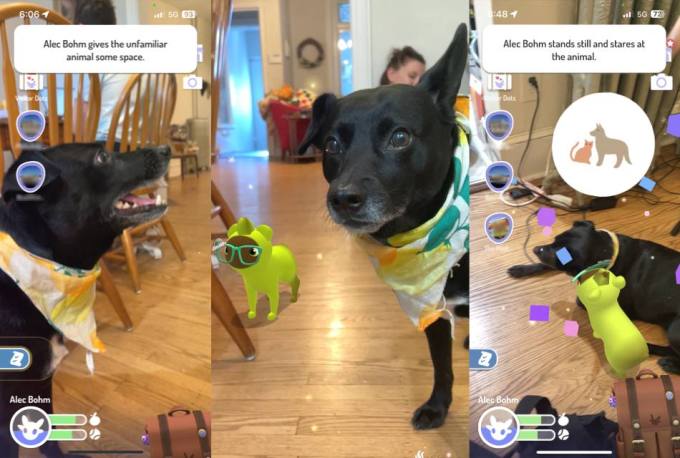From the makers of Pokémon GO comes another mobile game that brings cute little creatures to our fingertips: Peridot.
Like a ’90s Tamagotchi toy, Peridot is a pet simulator, but it takes place completely within augmented reality (AR). You can feed, play with, walk, breed and socialize with your Peridots, but don’t worry — if you take a break from the game, your creatures will not poop all over your screen and/or die.
Peridot is Niantic’s only game with original IP since Ingress, its first game, which was released 10 years ago. The so-called “real world metaverse” company has tried to replicate Pokémon GO’s smash success by making games for franchises like Harry Potter, Pikmin and the NBA; its Marvel and Monster Hunter games are also expected to launch this year. But without Pikachu, it’s hard to catch lightning in a bottle. Niantic shut down its Harry Potter game, and after a round of layoffs, it canceled four projects, including a Transformers game.
Peridot might not come with a built-in fanbase, but by doing something different, Niantic has a shot at success again.
When you start the game, you choose between three Peridot eggs to hatch — it almost feels like choosing a starter Pokémon. From there, your new baby gets a name (I named mine Brandon Marsh, after my favorite Phillies player, who kind of looks like he’s from the swamp), and you can start collecting XP points by feeding your Peridot, teaching it tricks, going on walks to real-world destinations and completing daily tasks. When your baby Peridot grows to a teen, it gets a personality trait (Brandon Marsh is “pensive,” while his brother/teammate Alec Bohm is “wild”), and when it becomes an adult, it can start breeding with other players’ adult Peridots.

Image Credits: Niantic
The Peridot breeding system is perhaps the most interesting aspect of the game. There are *ahem* about 2.3 x 10^24 possible Peridot combinations, a number so big that WolframAlpha won’t tell me how to say it in words, but it seems to be in the billions of billions. Niantic helpfully contextualizes this by describing the figure as around the number of all the grains of sand on all of the Earth’s beaches.
The idea of hatching endless amounts of cute little baby animals that neither poop nor die sounds lovely, but there’s a big catch: breeding is paywalled. Yes, for each Peridot you breed, you must use an item called a nest basket, which costs $5 (if it makes you feel better, Tamagotchi currently retail for about $20). But for users who don’t want to pay to play, this makes the game pretty limiting — there’s only so much you can do with one Peridot, especially after it reaches adulthood. And as if players didn’t already dislike being sold in-app items enough, Niantic is collaborating with Amazon to host a storefront of Peridot merch right in the Peridot app.
As far as the AR specs go, you need to work with the game to set it up for success. If you sit in your living room with the floor clearly visible, your Peridot can tell where the walls and furniture are and avoid them, making the game feel more realistic. But if you’re lying in bed at an angle where it’s not really clear what the floor is, your Peridot will glide through your pillows like they aren’t even there. Or, if you take your Peridots named after Phillies players to the upper deck at a Phillies game, it’s not going to be easy for Alec Bohm the Peridot to figure out where to situate itself while Alec Bohm the baseball player does his thing.

Image Credits: Photos by TechCrunch using Niantic’s Peridot app
Sometimes, though, the game’s ability to assess its surroundings is impressive. Already at launch, Peridots can recognize and interact with humans and animals. Alec Bohm the Peridot had a great time getting to know Bruce the dog, though he was a bit skittish at first.
Even if my Peridot can recognize real-world animals, there are some comically silly drawbacks to the game’s technology. Sometimes, your Peridot might want to go forage in the grass, sand or water, and the game uses AI to identify what terrain is in view. If you’re not by a body of water, some beta testers have found that you can simply show your Peridot a bottle of blue mouthwash or a photo of water to trick the game. I have a tapestry of a forest, which the game registers as a grassy habitat — a house plant will also do. It’s reminiscent of the early days of Pokémon GO, when people would put their phones into a bag that they tied to a ceiling fan to simulate walking.
After years of work, Peridot is finally available for iOS and Android users (so long as you have a relatively recent phone model that can support the AR game engine). An underrated challenge for Niantic has been the ability to get players to commit to more than one game; for example, as a dedicated Pokémon GO player, the idea of picking up Pikmin Bloom seemed like too much to juggle when I’m already in the habit of catching Pokémon when I go for a walk. But Peridot is very easy to play in small, few minute spurts, even if you don’t physically take your creatures for walks, since they can forage at nearby habitats without you.
Peridot is a lot of fun, but I haven’t even been playing for a whole week yet. My Peridots are still young and growing, but once they reach maturity, there will be little left to do but breed new eggs. And if you can only accomplish that by spending $5, then Peridot might see a steep drop in it user numbers. Or, Peridot could cultivate a dedicated enough fanbase that the drop off won’t matter much, so long as there are enough players paying to play. After all, Pokémon GO may no longer be the hot new thing, but it’s still making billions of dollars from in-app purchases every year.
